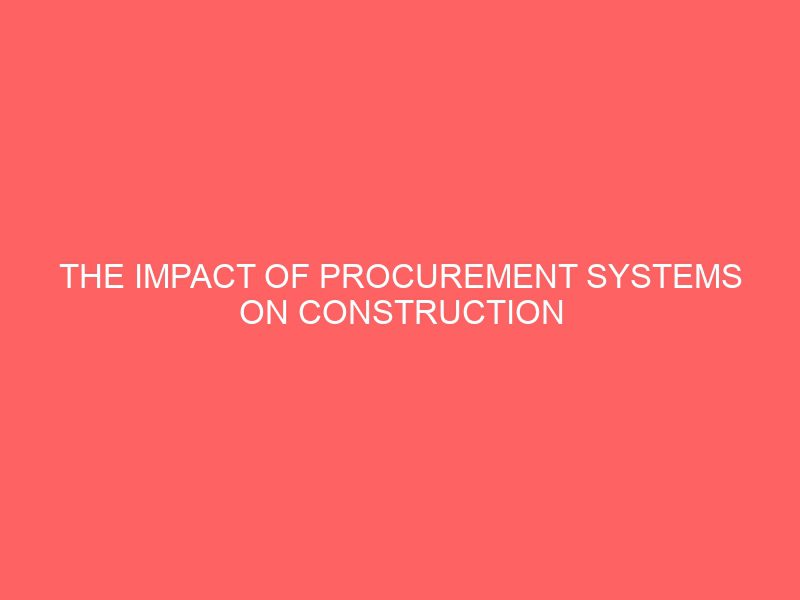Description
CHAPTER ONE
INTRODUCTION
1.1 BACKGROUND OF THE STUDY
The construction industry is an important part of the economical backbone in many countries (Ngai et al., 2002), often accounting for between 7-10 percent of the Gross Domestic Product (Winch, 1996, Voordijk et al., 2000). Furthermore, construction products and processes have a large impact on safety, health and environmental aspects (Bayliss et al., 2004). Since all human beings in modern societies are directly affected by its processes and/or products, the importance of a well-functioning construction industry is beyond doubt (Cheung et al., 2001, Ngai et al., 2002, Eriksson, 2007).
In many countries the construction industry has, however, attracted criticism for inefficiencies in outcomes such as time and cost overruns, low productivity, poor quality and inadequate customer satisfaction (Latham, 1994, Egan, 1998, Ericsson,2002, Chan et al., 2003). Practitioners, researchers and society at large have, therefore, called for a change in attitudes, behaviour and procedures in order to increase the chances for construction projects to be successful and result in improved end products (Love et al., 2000, Dubois and Gadde, 2002).
Increased complexity, uncertainty, and time pressure in construction projects have increased the need for cooperation among different project actors (Anvuur and Kumaraswamy, 2007). Traditionally, relationships are, however, very competitive and adversarial in the construction industry (Cheung et al., 2003), which to a large extent is due to the customary procurement procedures potentially causing many problems in all stages of the buying process (Eriksson and Laan, 2007). Therefore, in order to take advantage of collaboration, procurement procedures is one key improvement area and can contribute substantially to project success (Cheung et al., 2003, Eriksson, 2007).
A change of procurement procedures is, however, impeded by clients? habitual behaviour (Laedre et al., 2006). Although procurement procedures need to be tailored to enhance the fulfillment of different project objectives (Cox and Thompson, 1997,
Love et al., 1998, Wardani et al., 2006), clients tend to choose those procurement procedures they have a habit of using, regardless of any differences between projects (Laedre et al., 2006). In order to enhance change, an increased understanding of how different procurement procedures affect different aspects of project performance is vital. Earlier research efforts in this area have been limited to the investigation of how a single or a few specific procurement alternatives affect one or two project objectives. In order to achieve successful governance of construction projects a holistic and systemic approach to procurement procedures is crucial (Cox and Thompson, 1997, Eriksson and Pes?maa, 2007, Eriksson, 2008b). Since a systemic perspective on the effect of procurement procedures on different aspects of project performance is lacking in the construction management literature, this research effort aims to fill this theoretical gap that has potential to bring important practical implications.
Different studies have confirmed the use of various types of procurement methods for project delivery in Nigeria. Studies of Ogunsanmi, Iyagba and Omirin (2003), Ojo, Adeyemi and Fagbenle
(2006), and Dada (2012) all confirm the use of Traditional, Design and Build, Project Management, Construction Management, Labour only, Direct Labour and other types such as Alliancing, Partnering and Joint Ventures procurements in the Nigerian construction industry. The use of these procurement methods can significantly affect the performance of most projects.
1.2 STATEMENT OF THE PROBLEM
The Nigeria construction industry is modeled after the British system being our colonial master, although, since independence in 1960, it has incorporated the styles of other European countries, such as Italy, Germany and France (Mansfield, 1994). This industry is of paramount importance for employment and economic growth (Ogunsemi, 2004). The Nigerian construction industry forms nearly 70% of the nation?s fixed capital formation; Federal Office of Statistics (FOS)(2004), yet its performance within the economy has been, and continues to be, very poor due to cost overruns resulting to abandonment of projects. For example, the Nigerian construction industry?s contribution to employment has remained consistently at 1.0% over the last decade against the World Bank?s average observation of about 3.2% in developing countries (Idrus, 2008). The traditional design-bid-build system of procurement is still dominant in the Nigerian construction sector and this may likely continue to be the trend. In addition, the Nigerian construction sector comprises the clients, contractors, subcontractors, suppliers, and key professional actors responsible for design and supervision of projects. The professionals includes architects, engineers (structural and services), and Quantity Surveyors. There are professional bodies that regulate the activities of these professionals.
Delay in project execution is a major problem in the Nigerian construction industry. This occurs both in small and large projects. Virtually, all the projects executed over the years in Nigeria were faced with problem of delay in delivery. Odeyinka and Yusuf (1997) observed that seven out of every ten projects suffer delay in Nigeria. Nigerian construction industry is faced with problem of cost overrun. Ogunsemi and Jagboro (2004) noted that one of the most serious problems the Nigerian construction industry is faced with is the project cost overrun, with attendant consequence of completing projects at sums higher than the initial sum. Therefore, working with realistic project estimate is necessary at the outset of a project work, which would eliminate uncertainty and as well provide a platform for project success. Idrus and Sodangi (2008) also observed that the last decade has however exposed the declining level of clients? satisfaction from the built facilities as a result of poor quality performance in addition to the perennial problems of time and cost overruns in the Nigerian construction industry.
The Nigerian construction industry continues to occupy an important position in the nation?s economy even though it contributes less than the manufacturing or other service industries. This industry plays an important role in the economy, and the products of its activities are so vital to the achievement of national socio-economic development goals of creating job opportunities and social amenities and infrastructures (Anaman, 2007).
1.3 OBJECTIVES OF THE STUDY
The main aim of this study is to examine procurement systems and it impact on cost management and delivery. Specific objectives of the study are:
1. To identify various procurement systems commonly used by quantity surveyors in Owerri.
2. To examine challenges encountered when employing various procurement systems for construction projects.
3. To examine the impact of procurement systems on construction cost.
1.4 RESEARCH QUESTIONS
To guide the study and achieve the objectives of the study, the following research questions were formulated:
1. What various procurement systems are commonly used by quantity surveyors in Owerri?
2. What are the challenges encountered when employing various procurement systems for construction projects?
3. How do procurement systems affect construction cost?
1.5 RESEARCH HYPOTHESES
1. Ho: Variations in procurement systems do not affect construction cost.
Hi: Variations in procurement systems affect construction cost.
2. Ho: Challenges encountered when using procurement systems contribute do not contribute to construction cost overrun.
Hi: Challenges encountered when using procurement systems contribute to construction cost overrun.
3. Ho: There is no significant impact between procurement systems and construction cost management and delivery.
Hi: There is a significant impact between procurement systems and construction cost management and delivery.
1.6 SIGNIFICANCE OF THE STUDY
This study will be of importance to personnel in the construction industry and the general public because it would not only clarify but also create awareness of the extent to which inadequacies in cost management and procurement systems can adversely affect project performance. The study will also help contractors, clients, consultants and all parties involved in construction projects about ways of improving their current method of cost management and control.
The study will also be of great benefit for other student researchers? who may want to venture into the same subject matter. Having gotten results-both empirically and theoretically, the study will serve as a foundation for future research studies.
1.7 SCOPE OF THE STUDY
The study will cover some selected contractors from Owerri. All findings and recommendations from the study may not reflect the true view of the traditional roles and changing roles of quantity surveyors as the researcher could not cover a wider area due to financial and time constraints.
1.8 DEFINITION OF TERMS
? Procurement: This is the acquisition of goods, services or works from an outside external source.
? Procurement System: Procurement system? is a contemporary term, which is known to many practitioners and researchers of the construction industry by different terms; these include terms such as project approach, procurement methods, procurement delivery methods or project delivery.
? Project Procurement: Project procurement has been described as an organized methods or process and procedure for clients to obtain or acquire construction products.
? Open tendering: This is a procedure that allows practically any contractor to submit a tender for the work. This procedure involves either the client or consultant (on behalf) of the client placing a public advertisement giving a brief description of the work.
? Selective tendering: It consists of the client drawing up a short-list of contractors that are known to have the appropriate qualifications to carry out the work satisfactorily.
? Negotiated tendering: This method is applied in several or different contexts, but the essence is that tenders are obtained by the client inviting a single contractor of his/her choice to submit a tender for a particular project.
? Non-traditional procurement systems: This is a diversified contemporary procurement system that not only considers design and construction, but also considers financing, operating and facility management.
Construction: In the fields of architecture and civil engineering, construction is a process that consists of the building or assembling of infrastructure. Far from being a single activity, large scale construction is a feat of human multitasking. Normally, the job is managed by a project manager, and supervised by a construction manager, design engineer, construction engineer or project architect.
Deliverable: Deliverable is a term used in project management to describe a tangible or intangible object produced as a result of the project that is intended to be delivered to a customer (either internal or external). A deliverable could be a report, a document, a server upgrade or any other building block of an overall project.
Project management: this is the discipline of planning, organizing, motivating, and controlling resources to achieve specific goals. A project is a temporary endeavour with a defined beginning and end (usually time-constrained, and often constrained by funding or deliverables), undertaken to meet unique goals and objectives, typically to bring about beneficial change or added value.
Time: This is a dimension in which events can be ordered from the past through the present into the future, and also the measure of durations of events and the intervals between them.
Cost: A cost is the value of money that has been used up to produce something, and hence is not available for use anymore. In business, the cost may be one of acquisition, in which case the amount of money expended to acquire it is counted as cost.
Cost overrun: occurs when the final cost of the project exceeds the original contract value at the time of completion.
Good cost performance project: Project in which the cost overrun of the project does not exceed 10 percent of the initial budget.
REFERENCES
? Anvuur, A. & Kumaraswamy, M. (2007) ‘Conceptual Model of Partnering and Alliancing’. Journal of Construction Engineering and Management, 133 (3), 225-234.
? Bayliss, R., Cheung, S., Suen, H. & Wong, S.-P. (2004) ‘Effective Partnering Tools in Construction: A Case Study on MTRC TKE Contract in Hong Kong’. International Journal of Project Management, 22 (3), 253-263.
? Chan, D. & Kumaraswamy, M. (1997) ‘A Comparative Study of Causes of Time Overruns in Hong Kong Construction Projects’. International Journal of Project Management, 15 (1), 55-63.
? Cheung, S.-O., Lam, T.-I., Leung, M.-Y. & Wan, Y.-W. (2001) ‘An Analytical Hierarchy Process Based Procurement Selection Method’. Construction Management and Economics, 19 (4), 427-437.
? Cheung, S., Ng, T., Wong, S.-P. & Suen, H. (2003) ‘Behavioral Aspects in Construction Partnering’. International Journal of Project Management, 21 (5), 333-343.
? Cox, A. & Thompson, I. (1997) ‘Fit for Purpose Contractual Relations: Determining a Theoretical Framework for Construction Projects’. European Journal of Purchasing & Supply Management, 3 (3), 127-135.
? Dada, M.O. (2012), A second look: Stakeholders? Perceptions of Some Issues in Design?Bid-Build Procurement Practice in Nigeria. Journal of Sustainable Development, 5(1), 55-63.
? Eriksson, P. E. & Pes?maa, O. (2007) ‘Modelling Procurement Effects on Cooperation’. Construction Management and Economics, 25 (8), 893-901.
? Latham, M. (1994) Constructing the Team. London, HMSO.
? Ericsson, L. E. (2002) Sk?rpning Gubbar. SOU 2002:15, Byggkommissionen, Stockholm.
? Eriksson, P. E. & Laan, A. (2007) ‘Procurement Effects on Trust and Control in Client-Contractor Relationships’. Engineering, Construction and Architectural Management, 14 (4), 387-399.
? Ogunsanmi, O.E., Iyagba, R.O.A. and Omirin, M.M. (2003), A comparative Study of the Performance of Traditional and Labour only Procurements in Nigeria. Journal of Nigeria Institute of Building, 12-27.
? Laedre, O., Austeng, K., Haugen, T. & Klakegg, O. (2006) ‘Procurement Routes in Public Building and Construction Projects’. Journal of Construction Engineering and Management, 132 (7), 689-696.
? Love, P., Irani, Z. & Edwards, D. (2004) ‘A Rework Reduction Model for Construction Projects’. IEEE Transactions on Engineering Management, 51 (4), 426-440.
? Ngai, S., Drew, D., Lo, H. P. & Skitmore, M. (2002) ‘A Theoretical Framework for Determining the Minimum Number of Bidders in Construction Bidding Competitions’. Construction Management and Economics, 20 (6), 473-482.
? Winch, G. (1996) Contracting Systems in the European Construction Industry: A Sectoral Approach to the Dynamics of Business Systems. IN KRISTENSEN, R. W. A. P. H. (Ed.) The Changing European Firm: Limits to Convergence. London, Routledge.
? Voordijk, H., de Haan, J. & Joosten, G.-J. (2000) ‘Changing Governance of Supply Chains in the Building Industry: A Multiple Case Study’. European Journal of Purchasing &Supply Management, 6 (3-4), 217-225.







